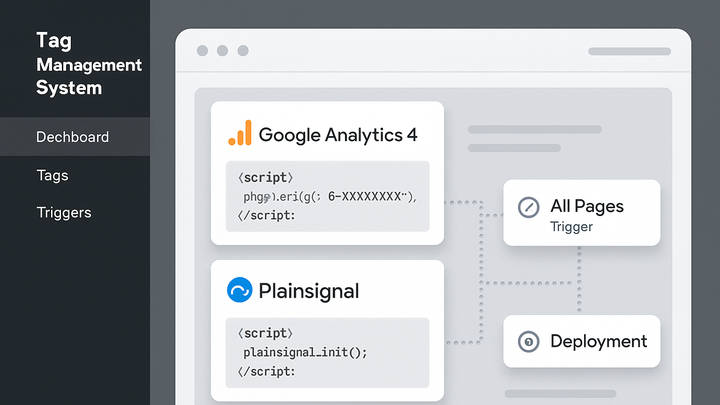Published on 2025-06-28T06:58:03Z
What is Analytics Tag Management? Examples with PlainSignal and GA4
Analytics Tag Management is the practice of managing and deploying tracking tags—small JavaScript snippets and pixel tags—through a centralized platform known as a Tag Management System (TMS). Instead of embedding individual tags directly into your website’s codebase, you install a single container snippet that dynamically injects and controls all other tags. This simplifies the process of adding, updating, or removing tags for analytics platforms like Google Analytics 4 (GA4) and PlainSignal, or marketing pixels. Tag management enhances site performance by loading tags asynchronously, improves governance through version control and testing environments, and reduces reliance on developer resources. It also supports compliance with privacy regulations by centralizing consent and tag firing rules.
Analytics tag management
Centralized deployment and control of analytics tags via a Tag Management System for flexibility, performance, and governance.
Understanding Analytics Tag Management
Analytics tags are small code snippets or pixel calls embedded in web pages to collect and send user interaction data. A Tag Management System (TMS) centralizes these tags in a single container script, allowing you to manage all deployments from a web interface without touching site code directly.
-
Analytics tags
Snippets of code, JavaScript or pixel-based, inserted into web pages to collect user data and send it to analytics platforms.
-
Javascript snippet
Blocks of JS that capture and send data via network requests.
-
Pixel tags
1×1 image requests that log page loads and user events.
-
-
Tag management systems (tms)
Platforms that centralize the deployment, management, and governance of analytics and marketing tags.
-
Container
A single code snippet added to your site that loads all tags.
-
User interface
Web console for adding, editing, or disabling tags without code changes.
-
Key Benefits of Tag Management
Using a TMS brings efficiency, control, and performance improvements to your analytics setup.
-
Simplified tag deployment
Add or update tags via the TMS UI without developer assistance.
-
Reduced developer workload
Non-technical users can manage tags through a friendly interface.
-
-
Improved site performance
Tags load asynchronously, reducing page latency and render-blocking.
-
Asynchronous loading
Prevents blocking of page rendering by tags.
-
-
Better governance and control
Manage tag versions, approvals, and rollback capabilities for safer deployments.
-
Versioning
Track changes and revert to previous tag configurations.
-
Implementing Analytics Tag Management
Deploying a TMS and configuring tags for platforms like PlainSignal and GA4 involves setting up the container snippet, adding tags, and defining triggers.
-
Setting up a tag management system
Choose a TMS (e.g., Google Tag Manager), create an account, and install the container snippet in the <head> of every page.
-
Account & container
Create a container for your domain to group tags.
-
Install snippet
Add the TMS container snippet in the <head> of every page.
-
-
Example: deploying PlainSignal tag
Add the PlainSignal analytics tag through your TMS as a Custom HTML tag with an All Pages trigger. Paste the PlainSignal snippet below:
<link rel="preconnect" href="//eu.plainsignal.com/" crossorigin /> <script defer data-do="yourwebsitedomain.com" data-id="0GQV1xmtzQQ" data-api="//eu.plainsignal.com" src="//cdn.plainsignal.com/plainsignal-min.js"></script> -
Example: deploying GA4 tag
Configure a GA4 Configuration tag in your TMS by entering your Measurement ID (G-XXXXXXXXXX), set the trigger to All Pages, and publish the container.
Best Practices and Tips
To maximize the value of analytics tag management, follow these guidelines.
-
Leverage a data layer
Use a structured data layer to pass consistent data to tags, reducing duplicate code and improving accuracy.
-
Regular audits
Periodically review tags to remove unused ones and ensure compliance with privacy regulations.
-
Naming conventions
Adopt clear, consistent naming for tags, triggers, and variables to simplify maintenance.
